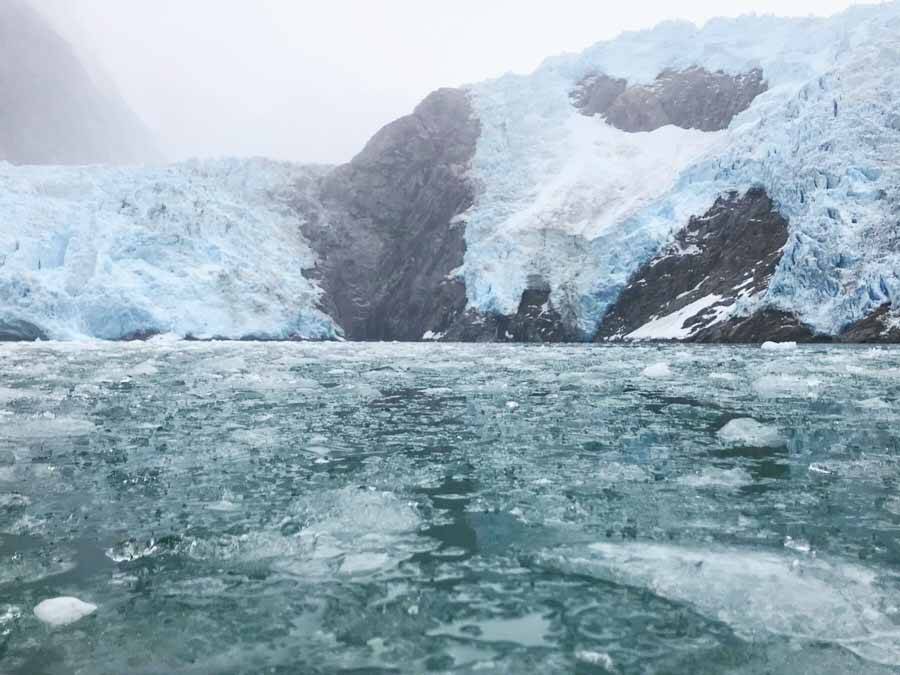There are a lot of glaciers around here. Driving, flying, boating around you can stumble across a glacier you may never have seen or heard of, but it’s safe to say it has a name, whether official or unofficial.
The most well known, of course, is Exit Glacier. The brief way to tell the story is “Jewel’s grandfather traversed the Harding Icefield from Homer to Seward and exited on Exit Glacier.” But, after doing a little more research, one can find that a 10-person mountaineering party, including Yule and Otto Kilcher, became the first to successfully cross the Harding Icefield in 1968.
Starting from Chernof Glacier, the adventurers trekked east until they found themselves descending Resurrection Glacier. Newspapers reported that the team had made it and found their way down the “Exit Glacier,” and the new name stuck.
At the beginning of that story, though, is Chernof Glacier, which was named in 1913 for Ivan Chernof, an employee of the Russian American Fur Company. And while the newspaper renamed Resurrection to Exit Glacier, Chernof was named by A.H. Brooks of the U.S. Geological Survey.
There’s also a 3.5-mile long glacier in the Kenai Mountains named Dinglestadt Glacier for Chernof’s companion, Konstantin Dinglestadt. In 1834, while working with the fur company, the pair explored the west coast of the Kenai Peninsula, earning each of themselves a glacier in the process.
While on gold and coal-mining expeditions, Russian geologist Petr Doroshin visited Resurrection Bay and “described a landscape in which glaciers known by Russian names cascaded down the mountainous entrance to the deep bay,” according to the National Park Service, which has wonderful resources on how a lot of the beautiful features in Kenai Fjords National Park and beyond got their names.
The Russian names that Doroshin heard didn’t stick, though, and the cascading glaciers have found new names.
Aialik Glacier was named by geologists U. S. Grant and D. F. Higgins of the USGS, interpreting a Russian recording of an Eskimo name for the glacier, Bukh(ta) Ayalikskaya.
From there, Grant and Higgins went on a naming spree. Grant, who was the chair of the geology department at Northwestern University, decided to name Holgate Glacier, also in Aialik Bay, for the Dean of the College of Liberal Arts at the college, Dr. Thomas F. Holgate. (Not to be outdone, last month my co-worker brought in some doughnuts for us all to share.)
Grant did get familial, and named Addison Glacier after his eldest son, Addison Winchell, saving the real Northwestern adoration for Northwestern Lagoon, which holds Northwestern Glacier, as well as Harris Glacier, named for Abram Harris, Northwestern’s president from 1906 to 1916.
But I fell into the glacier research crevasse for interesting stories and fun factoids, not for the Northwestern naming tour of Grant and Harris. It turns out though, that most glacier names are derived in relatively boring ways. Godwin glacier? Named for the stream that drains it — Godwin River.
Even simpler is Split Glacier, in the North Arm of Nuka Bay, named because a large boulder has split the glacier, forcing the ice to flow in two paths.
And, I can’t find any national park paper or research online to back me up on this besides word of mouth, but I think Bear Glacier, the largest of the Harding Icefield, was so named because bears were spotted on it. I’ll go to the library and borrow a copy of “Alaska Place Names” by Alan Edward Schorr or “Dictionary of Alaska Place Names” by Donald Orth, both heavily cited by the National Park Service, to confirm my thesis.
Spencer Glacier, though? That one has a cool story that I learned during this year’s Solstice Seward Cemetery tour led by local historian Lee Poleske.
Poleske read the obituary of Edward A. Spencer, a general timekeeper with Alaska Central, who attempted to travel at night across the glacier that now bears his name. He died in 1905 but wasn’t found until a year later.
“Lying face downward with the hands clasped across the forehead, the body of Edward A. Spencer was found in a slight depression of the slope above the glacier opposite mile 53 of the railroad Saturday Afternoon,” the obituary reads.
And now we have Spencer Glacier in the Chugach National Forest.
My favorite glacier and glacier name, although it may be unofficial, is back in Aialik Bay next to Holgate Glacier. When facing Holgate Glacier if you look to the left you may be shocked to see an unsuspecting glacier flowing into the bay. That’s Surprise Glacier.
Although not as well known as the one in Prince William Sound bearing the same name, it’s a welcome surprise in a bay full of homages to Northwestern University.
Kat Sorensen is a writer living in Seward. She can be reached at katsorensen.nj@gmail.com

